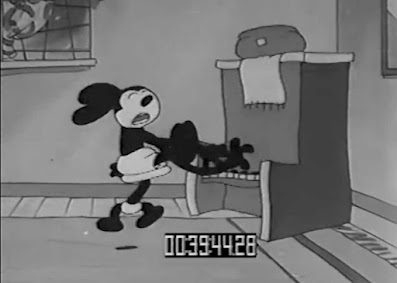
Until the mid 40s, Fox had many issues with the Terrytoons Studio, and over the years complaints were regularly sent. Particularly, the lack of true star characters. The likes of Farmer Alfalfa and Kiko the Kangeroo (who only lasted one season to begin with) were not enough for Fox's liking. This all changed in 1942, with the surprise hit of "The Mouse of Tomorrow" introducing the first major hit for the studio, Mighty Mouse! Of course, Terry didn't stop there, further promoting Gandy and Sourpuss as stars, and developing new ones. In 1947, Paul Terry released his new set of characters, and the ones he considered his best, Heckle and Jeckle!
The Story team at Terrytoons figured out their star Magpies quick. The film I'm talking about, THE INTRUDERS, is only the 4th cartoon staring them, and introduces a new character to their series, Chesty, or Clancy, or whatever name was pulled in the rotation for that day (see how much Terry cared about branding his characters?). Eitherway, let's get into the cartoon!

Heckle and Jeckle are two homeless magpies looking for a spot to stay. They find a nice, lush mansion and describe with GREAT detail over a panning BG. Terrytoons, being a budget studio, needed these kinds of moments to produce the cartoons quick, but at least the pleasant scenery is still there. After noting the silence, we see Chesty chase out the critters from the yarn, warning them for the last time. With his temper and grungy nature, Chesty serves a role similar to Farmer Alfalfa's in THE UNINVITED PESTS, but is made a little more intelligent, and less hot tempered.
Per usual, Heckle and Jeckle don't listen, and go in without interference. After Chesty threatens to skin the next trespassers alive, the NY speaking Magpie agrees with him out loud, and as they run off, Chesty thinks he just hears something as he sits down to have a drink, with gags of the Magpies assisting him out of course. Right before its bottoms up, he gets back up after hearing obnoxious singing.

This cartoon, while fun, is admittedly a little hard to talk about, so the rest of this article shall server more so as a gag highlight than anything. My apologies if it disappoints, but this cartoon does present some fine touches.
-Chesty doesn't even care that Heckle hit him with a mallet, and his ego insists on more. It backfires of course, with a funny pose. Terrytoons often used broad, vaudeville slapstick where characters quickly got back up and without any pain shown more than any other studio, and this is a good demonstration of it. Chesty is only down for 8 seconds

-After a few bits such as the favorite "removing the window from existence" gag used often, we get to a repeat from their first appearance (the aforementioned UNINVITED PESTS) of Heckle and Jeckle looking to frantically undo their own mayhem with saving Chesty from drowning. Though, after getting him out from the pool, they decide its best to put him back in once he's alright. Instead of letting him go from the crane, Chesty is kicked, sinking the rowboat in the process. Another funny example of broad slapstick, as the kick is absurd and funny alone

And what would a good cartoon be without some nice character animation? Another classic Terry joke was unexpected gifts causing harm, where Carlo Vinci animates Chesty being fooled by a bomb that shoots out a box, that pops out a bone that's actually an atomic bomb! You'll notice how expressive he is in moment, and how clear his emotions are read from pose to pose, changing with each phase of the bomb to box to bone to a-bomb.

In a ending similar to Lantz's Ration Bored, Heckle and Jeckle were also killed from the explosion, and managed to make it past "The Pearly Gates". When Chesty realizes, the chase continues into the Iris out!
Overall, a fun Terrytoon, full of everything that makes them fun: vaudevillian slapstick, good acting from Dayton Allen, and excelling timing that only gets wilder in pacing. Old tricks are used, as are some new ones. Heckle and Jeckle continued to appear more and more over 1947, proving quick stars, as humor was naturally executed well. The best of them are usually in line with other studio's bests with their screwball characters.
While a rather short article this time, I hope some articles related to elements behind them show up soon that I've been planning. Next week's cartoon should be more in detail too!































